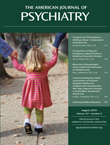To the Editor: We thank Dr. Uchida et al. for their interest in our recent article. Our response to their concerns are as follows. First, as we stated in the article, the primary outcome measure was relapse, namely, the estimated time from entry to relapse and the risk of relapse by the end of the study. In order to compare the primary outcome measure between the three groups, survival analysis, rather than chi-square test, is needed. Chi-square test is not appropriate here because relapses at different follow-up evaluations have different clinical implications. In addition, in the statistical analysis section, we clearly stated that the survival analyses included patients who relapsed and those who were lost to follow-up evaluation without documented relapse and were not considered relapsed at their last assessment, meaning that we examined dropout rates as a result of "relapse" and "any reason other than relapse" concurrently rather than separately. Second, because of logistical reasons, some secondary outcome measures, such as cognition, quality of life, etc., were not included in this study. Third, it is true that some patients were maintained on <2.0 mg/day in our sample. The Guidelines for the Prevention and Treatment of Schizophrenia in China recommend 2–6 mg/day as the therapeutic dose of risperidone for Chinese patients, a lower figure than the recommendation for their Caucasian counterparts (
1). Since the recommended therapeutic dose range of risperidone for Chinese patients is lower than that for their Caucasian counterparts, the maintenance dose should be lower also; that is, the lowest dose of risperidone approved for Chinese adults with schizophrenia is not 2.0 mg/day but less than that. Because the flooring dose of maintenance treatment with risperidone for Chinese patients has not been determined, a rather cautious and closely monitored dose reduction strategy could hardly raise serious ethical considerations. This is particularly true in light of the placebo-controlled antipsychotic trials in the long-term treatment of schizophrenia. Furthermore, in our study, we did not challenge the notion that moderately low dose treatment may be as effective as the standard dose therapy because, in addition to the review article by Dr. Uchida et al., there have been several other studies supporting this strategy. Our study focused on the optimal length of the initial therapeutic dose of risperidone following the acute phase of treatment rather than comparing the effects between any low dose treatment and the standard dose. Fourth, in clinical practice patients on maintenance treatment should take higher doses of antipsychotic drugs in case of symptomatic deterioration. Since we explored the optimal length of the initial therapeutic dose of risperidone following the acute phase of treatment in this study, all participants had to adhere to dose reduction and treatment rules; otherwise, they were to be excluded. This was not a natural, observational study. Finally, it is true that Figure 3 showed that the Positive and Negative Syndrome Scale (PANSS) total score increased in the 26-week group before the dose reduction (approximately <2 points). In the Results section, the changes in the PANSS total scores among the three groups from baseline to endpoint were compared using mixed-model analyses. There were no significant differences among the three groups in the change of the total PANSS score or in the interaction between group and time. Again, the primary outcome measure of the study was the estimated time from entry to relapse and the risk of relapse rather than change of the total PANSS score.
Taken together, our results support the notion that at least 1 year of maintenance risperidone treatment at the initial therapeutic dose is safe and more effective in relapse prevention than the reduced dose strategies.

